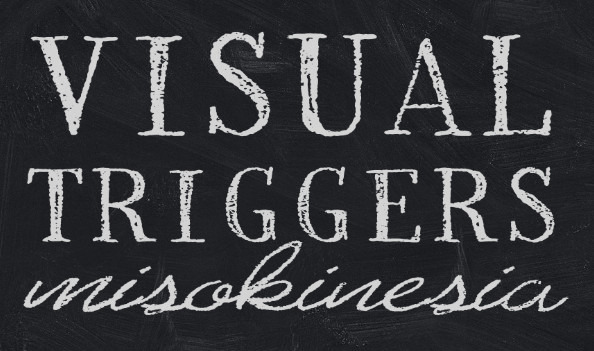MISOKINESIA (Visual Triggers)
People have begun using the word misokinesia to describe a sensory sensitivity to visual stimuli. Having misokinesia means that a person has negative emotional responses to seeing a particular movement or repetitive motion.
Visual triggers have been part of misophonia ever since the Jastreboff’s first published their ground-breaking articles on something new that they called misophonia. They coined the name misophonia over 20 years ago, and they included visual triggers in their description of misophonia.
People with misokinesia have visual triggers, and those with misophonia have issues with sound. However, not everyone that has misophonia will have misokinesia.
A recent request for examples of visual triggers produced many hundreds of responses from the Facebook misophonia support group members. Many of the examples involved issues with the face (especially chewing) or movements of fingers, hands, and legs. Some environmental triggers were also mentioned, such as windshield wipers, fans, and lights.
Visual triggers produce the same reactions from people as sound triggers do. They cause a person to experience negative emotions such as anger, disgust, frustration, rage, and more. Like misophonia, a person’s sensitivity fluctuates depending on unknown factors. These are possibly the same ones that affect misophonia: sleep, diet, exercise, environment, the visual source, etc. Visual triggers are not universal, and they are unique to the individual.
Unlike misophonia, one cannot lessen the impact of the trigger the way a person with misophonia can wear earplugs, headphones, etc. But the general avoidance techniques used for misophonia can be beneficial.
Articles and references that support visual triggers (misokinesia) as being part of misophonia:
John Cline Ph.D., Understanding Misophonia – “the emotional response to certain sounds can become associated with visual cues” (https://www.psychologytoday.com/us/blog/sleepless-in-america/201809/understanding-misophonia)
The Misophonia Activation Scale (MAS-1) included visual stimuli: “Sufferer may re-imagine the trigger sound and visual cues over and over again” – Guy Fitzmaurice, Misophonia UK – 2012 http://www.misophonia-uk.org/the-misophonia-activation-scale.html
Julie Ryan Evans, Alana Biggers, MD, June 27, 2017, https://www.healthline.com/health/misophonia, Understanding Misophonia: What Is It? – “Some with misophonia also have visual triggers.”
Misophonia: Diagnostic Criteria for a New Psychiatric Disorder – Arjan Schröder, Nienke Vulink, Damiaan Denys – 2013 https://www.ncbi.nlm.nih.gov/pmc/articles/PMC3553052/
Webber T. A., Storch E. A. (2015). Toward a theoretical model of misophonia. Gen. Hosp. Psychiatry 37 369–370. 10.1016/j.genhosppsych.2015.03.019 – “During an interview, the young girl reacted strongly to certain auditory and visual stimuli and demanded that the sound stop.”
Misophonia, Misokinesia, and the Brain – New research replicates the brain basis of misophonia – Jennifer J. Brout Psy.D – 2019 https://www.psychologytoday.com/us/blog/noises/201908/misophonia-misokinesia-and-the-brain
What is Misokinesia?, Allergic to Sound, Feb 5, 2015, https://www.allergictosound.com/articles/misokinesia/ – “(visual) triggers alongside their misophonia (sound) ones.”
Michiel Poorthuis, M.D., Paul Nestadt, M.D., Damiaan Denys, M.D., PhD., Misophonia, https://www.hopkinsguides.com/hopkins/view/Johns_Hopkins_Psychiatry_Guide/787169/all/Misophonia – “Possible triggers include eating sounds (smacking, swallowing, apple eating), breathing sounds, finger/hand sounds (typing, pen clicking, nail clipping), foot sounds (footsteps, the sound of high heels), and repetitive visual movements (leg rocking)”
Arjan Schröder, Guido van Wingen, Nadine Eijsker, Renée San Giorgi, Nienke C. Vulink, Collin Turbyne & Damiaan Denys, https://www.nature.com/articles/s41598-019-44084-8, Misophonia is associated with altered brain activity in the auditory cortex and salience network – “Our results demonstrate that audiovisual stimuli trigger anger and physiological arousal in patients with misophonia.”
Oregon Tinnitus & Hyperacusis Treatment Clinic, Inc., Misophonia, https://tinnitus-audiology.com/misophonia/ – “the fact that visual triggers are common as well.”
Christopher Spankovich and James W. Hall III, The Misunderstood Misophonia, https://www.audiology.org/sites/default/files/resources/misophonia.pdf – “Approximately 12 percent of the sample reported visual triggers.”

